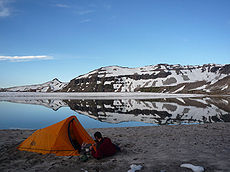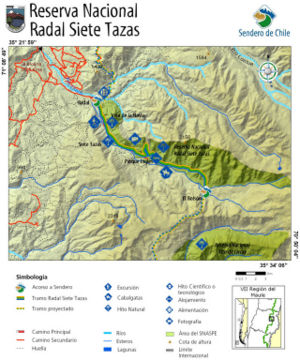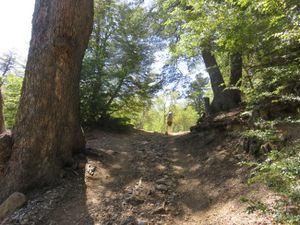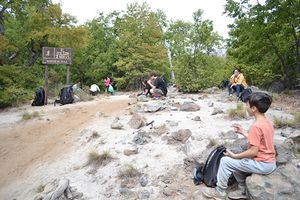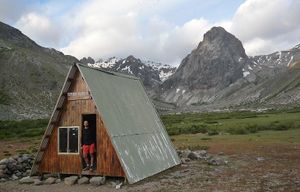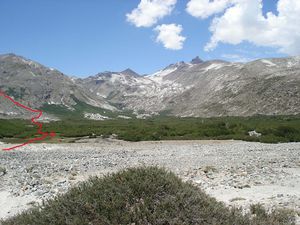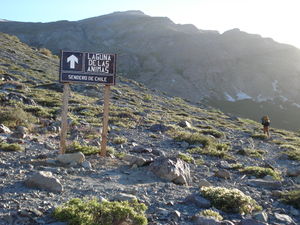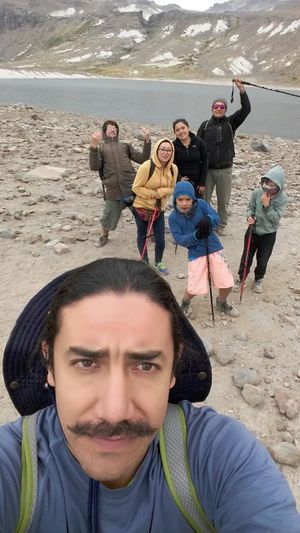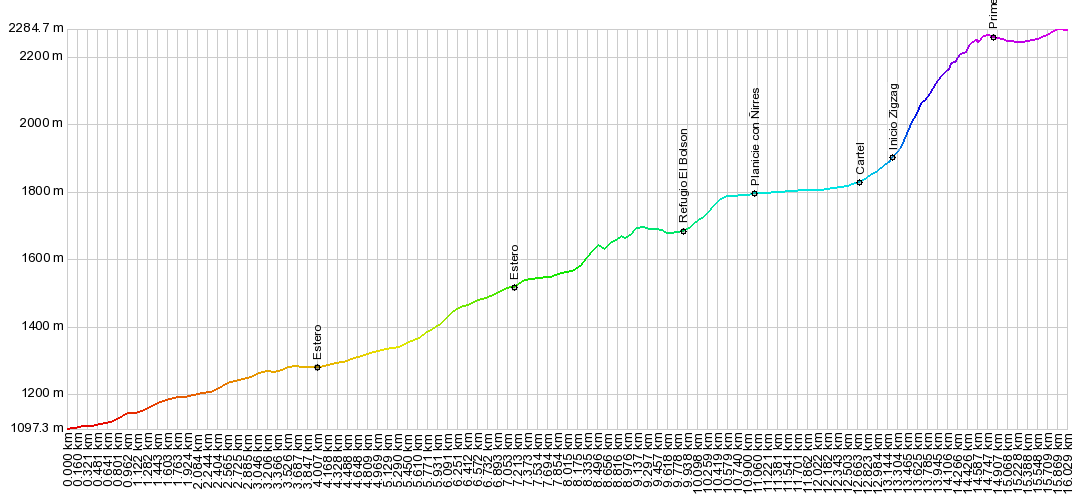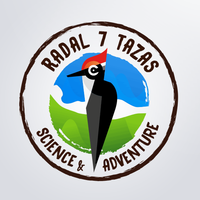Diferencia entre revisiones de «ENG:Laguna de Las Ánimas»
(→Description of the route) |
|||
| (No se muestran 17 ediciones intermedias de 2 usuarios) | |||
| Línea 1: | Línea 1: | ||
| + | [[ES:Laguna Las Ánimas]] | ||
[[category:KMZconTrack]] | [[category:KMZconTrack]] | ||
| + | {{indexed}} | ||
{{Science and adventure}} | {{Science and adventure}} | ||
| − | {{ | + | {{RutaForme |
|Actividad=Trekking | |Actividad=Trekking | ||
|País=Chile | |País=Chile | ||
| Línea 7: | Línea 9: | ||
|BellezaEscenica=Atractiva | |BellezaEscenica=Atractiva | ||
|Atractivos=Vistas panorámicas, Lago | |Atractivos=Vistas panorámicas, Lago | ||
| − | | | + | |Duracion=2 días |
|Sendero=Tramos sin sendero | |Sendero=Tramos sin sendero | ||
|Señalizacion=Insuficiente | |Señalizacion=Insuficiente | ||
| Línea 14: | Línea 16: | ||
|Latitud1=-35.476367 | |Latitud1=-35.476367 | ||
|Longitud1=-70.994300 | |Longitud1=-70.994300 | ||
| − | |Distancia= | + | |Distancia=32000 |
|MetrosAscenso=1273 | |MetrosAscenso=1273 | ||
|MetrosDescenso=88 | |MetrosDescenso=88 | ||
| Línea 29: | Línea 31: | ||
[[File:Laguna_Las_Animas.jpg|frame|center|Laguna de las Ánimas, January 2010]] | [[File:Laguna_Las_Animas.jpg|frame|center|Laguna de las Ánimas, January 2010]] | ||
| + | [[File: Mapa_radal_7_tazas.jpg|thumb|right|Map of the national park]] | ||
==Best time of year to go== | ==Best time of year to go== | ||
[[File:bosque Siete Tazas radal.JPG|thumb|In the southern beech forest sector between Parque Inglés and Refugio El Bolsón. December 2016]] | [[File:bosque Siete Tazas radal.JPG|thumb|In the southern beech forest sector between Parque Inglés and Refugio El Bolsón. December 2016]] | ||
| Línea 43: | Línea 46: | ||
==Description of the route== | ==Description of the route== | ||
| − | First of all, just for the avoidance of doubt, although it is in the same | + | First of all, just for the avoidance of doubt, although it is situated in the same protected wilderness area as them, this route does not include the actual Siete Tazas waterfalls, which are accessed by way of a short boardwalk located further down the hill, in other words not as far up the road from Radal. The first half or so of the Laguna de las Ánimas route simply consists of hiking up the trail to [[Refugio_El_Bolsón_(english)|Refugio El Bolsón]], which is a very popular standalone trek in its own right and takes four hours, one way. The hike to Laguna de las Ánimas is therefore the "complete" trek for the national park, whereby you cross from one end of it to the other (and then back again). The upper part of the trek is located around the head of the valley of the Río Claro -- the Siete Tazas river. Don't get confused by the nomenclature. In reality, Laguna de las Ánimas itself is a small mountain lake, situated just outside the park boundary. |
| − | The starting point of this trail is | + | The starting point of this trail is at Parque Inglés (km 0 of the trek - 1100m above sea level) which is where the access road into the national park ends, and where people have to park their vehicles if they wish to proceed any further. You'll need to sign in at the CONAF rangers' office on the left-hand side of the road. Start the walk by passing around the back of the CONAF base complex through a turnstile following the signs to the trails. After you get out of the complex, you need to turn right onto a dirt road which then bears around to the left. 150 m further on, you will see a path, which exits the dirt road to the right, along with a route sign pointing in the direction of Refugio El Bolsón, and that it's four hours' walk away. This is the trail you want to take. You have to keep following it until you get to Refugio El Bolsón, ignoring all of the secondary paths that you'll see branching off to the sides of the main route as you go along (most notably, Sendero Mala Cara and Sendero La Montañita). Try not to forget this! 🙂 On the way, you'll see signs saying "3 hours to go", "2 hours to go" and "1 hour to go" in Spanish -- see the second photo in the column of images to the right of this text -- which will give you some idea of how close you are to your destination. Obviously, the time periods that appear on these signs are only rough estimates but they should be reasonably accurate for a person walking at a normal pace. Most of the signs along the route to Refugio El Bolsón are clearly marked and there aren't very many places where you can expect to get lost easily. |
The opening section of the route is very pleasant. It passes through dense forest and has a relatively flat gradient. After about 20 minutes of walking, you'll get to a small clearing (km 2.4 - 1212m). A few steps further on is a small stream, which gets dried up by the middle of summer. You'll then pass a quincho [= a simple, local wooden gazebo] and a wooden sign with a map on it just ahead of it, in the same clearing. You'll also go past the entrance to Sendero Mala Cara less than 10 minutes later. In km 3.7 of the walk (altitude 1282m), you reach a fork in the trail . You need to take the right fork in order to keep heading towards Refugio El Bolsón instead off veering off left to Sendero Montañita. There are signposts there to help you out. 330 metres further along, you have to cross another stream.You then have to keep following the trail as it winds its way uphill, through the southern beech forest. After another hour's walk, the scenery begins to change. The vegetation thins out considerably and turns into scrubland. | The opening section of the route is very pleasant. It passes through dense forest and has a relatively flat gradient. After about 20 minutes of walking, you'll get to a small clearing (km 2.4 - 1212m). A few steps further on is a small stream, which gets dried up by the middle of summer. You'll then pass a quincho [= a simple, local wooden gazebo] and a wooden sign with a map on it just ahead of it, in the same clearing. You'll also go past the entrance to Sendero Mala Cara less than 10 minutes later. In km 3.7 of the walk (altitude 1282m), you reach a fork in the trail . You need to take the right fork in order to keep heading towards Refugio El Bolsón instead off veering off left to Sendero Montañita. There are signposts there to help you out. 330 metres further along, you have to cross another stream.You then have to keep following the trail as it winds its way uphill, through the southern beech forest. After another hour's walk, the scenery begins to change. The vegetation thins out considerably and turns into scrubland. | ||
| Línea 51: | Línea 54: | ||
At km 7.3 of the trek (1520m above sea level) you have to cross a moderately wide stream, which flows down from Cerro Piuquenes. Just 600 metres further ahead, the trail arrives at the Río Claro, which carries a much greater volume of water and has a very powerful current. DO NOT ATTEMPT TO CROSS THE RIVER. Just keeping walking along the north bank. Further on, the climb starts to get a little bit steeper. After a few more minutes of walking the Valle del Indio starts to open up on you. You'll see ñirre shrubs all around, and should be able to make out Cerro Tres Puntas and the Salto del Indio (a waterfall, pictured below), in the distance. About 45 minutes after you cross the stream, you should get to the small CONAF shelter: "Refugio El Bolsón" [km 10.1 -- Altitude: 1686m], which is also a camping area. There is plenty of space to pitch tents close to a small brook that flows through the site. This camping spot also offers an outstanding view of a dramatically steep and rocky peak -- the appropriately-named, Colmillo del Diablo [= The Devil's Fang], which is located just two kilometres to the North. | At km 7.3 of the trek (1520m above sea level) you have to cross a moderately wide stream, which flows down from Cerro Piuquenes. Just 600 metres further ahead, the trail arrives at the Río Claro, which carries a much greater volume of water and has a very powerful current. DO NOT ATTEMPT TO CROSS THE RIVER. Just keeping walking along the north bank. Further on, the climb starts to get a little bit steeper. After a few more minutes of walking the Valle del Indio starts to open up on you. You'll see ñirre shrubs all around, and should be able to make out Cerro Tres Puntas and the Salto del Indio (a waterfall, pictured below), in the distance. About 45 minutes after you cross the stream, you should get to the small CONAF shelter: "Refugio El Bolsón" [km 10.1 -- Altitude: 1686m], which is also a camping area. There is plenty of space to pitch tents close to a small brook that flows through the site. This camping spot also offers an outstanding view of a dramatically steep and rocky peak -- the appropriately-named, Colmillo del Diablo [= The Devil's Fang], which is located just two kilometres to the North. | ||
| − | On leaving Refugio El Bolsón, the trail heads upwards and goes through an area of ñirre shrubs. You have to be careful around here because it's easy to get lost. There are several orange arrows that point towards the river, but they take you to the "Salto del Indio" waterfall rather than Laguna de las Ánimas so, watch out for that. After about 20 minutes of walking you will have made your way through the first area of ñirres plants. You then carry on through a clear and open section in order to cross a wide and rocky ravine, with little in the way of vegetation growing | + | On leaving Refugio El Bolsón, the trail heads upwards and goes through an area of ñirre shrubs. You have to be careful around here because it's easy to get lost. There are several orange arrows that point towards the river, but they take you to the "Salto del Indio" waterfall rather than Laguna de las Ánimas so, watch out for that. After about 20 minutes of walking you will have made your way through the first area of ñirres plants. You then carry on through a clear and open section in order to cross a wide and rocky ravine, with little in the way of vegetation growing inside it. |
Just beyond the rocky ravine, you get to a meadow with more ñirre bushes. The path basically crosses this section close to the foot of the slopes on the northern side of the valley. Having said that, it's really hard not to lose sight of the trail. Keep following it by looking out for bare patches where there is no grass growing. Unfortunately, the ñirre bushes' branches tend to cover up these bare patches. So, just keep being patient, and wherever possible, try to break off the branches that you find are creating the most obstruction, in order to help out anybody else who uses the trail after you. | Just beyond the rocky ravine, you get to a meadow with more ñirre bushes. The path basically crosses this section close to the foot of the slopes on the northern side of the valley. Having said that, it's really hard not to lose sight of the trail. Keep following it by looking out for bare patches where there is no grass growing. Unfortunately, the ñirre bushes' branches tend to cover up these bare patches. So, just keep being patient, and wherever possible, try to break off the branches that you find are creating the most obstruction, in order to help out anybody else who uses the trail after you. | ||
| Línea 61: | Línea 64: | ||
The ascent from Refugio El Bolsón to Laguna de las Ánimas typically takes three hours, or less. | The ascent from Refugio El Bolsón to Laguna de las Ánimas typically takes three hours, or less. | ||
| − | [[Archivo:Perfil_LagLasAnimas.PNG|centre|Terrain Elevation Profile (estero = stream... planicie = plain... cartel = sign... inicio zigzag = start of the zig-zag)]] | + | [[Archivo:Perfil_LagLasAnimas.PNG|centre|frame|Terrain Elevation Profile (estero = stream... planicie = plain... cartel = sign... inicio zigzag = start of the zig-zag)]] |
==Access Permits/Entry Charges== | ==Access Permits/Entry Charges== | ||
| Línea 89: | Línea 92: | ||
==Hiring a mountain guide== | ==Hiring a mountain guide== | ||
| − | + | [[File:Science_&_Aventure.png|thumb|200px|Science & Adventure]] | |
| − | + | *[https://www.facebook.com/ScienceAndAdventure Science & Adventure. WE ARE READY AND WAITING FOR YOU!] | |
| − | + | ||
| − | + | ||
| − | + | ||
| − | [[File:Science_&_Aventure.png| | + | |
==Photo Gallery== | ==Photo Gallery== | ||
Revisión actual del 11:52 1 may 2019
|
|
|
| |||||||||||||||||||||||||||||||||||||||||||||
Best time of year to go
Between October and April. During the rest of the year, it gets really cold and the top end of the trail tends to be covered in snow.
Getting there
By car
Exit the Panamerican Highway (Ruta 5 Sur) to the East, via the town of Molina, then follow the K-175, followed by the unpaved K-275 until you reach the small village of Radal, which is situated 72 km to the southeast of Molina, and serves as the gateway to the national park. You then have to keep following the same road uphill for around another 10 km in order to get the CONAF park rangers' office in Parque Inglés
In order to get to the village of Radal and the national park from Talca, you have to leave the city to the East, passing through the settlements of Lo Beño and La Placeta on the way. The first 30 km of this route are paved. The remaining 40 km consist of travelling along a decent-quality gravel road. The road does get narrow in certain spots but it does have passing places, which you might have to pull into, from time to time, in order to allow oncoming traffic to go past you.
By public transport and hitchhiking
From Santiago, the only bus company that goes directly to Molina is PULLMAN DEL SUR. These buses leave from the "Terminal Alameda"/"Terminal de Santiago" complex , which is located next to the "Universidad de Santiago" Metro station. It isn't possible to buy a return ticket from a Santiago but the price of a one-way ticket should cost CLP $4,000-$5,000
During the peak season -- largely defined, in this case, as from Christmas time to the end of February -- buses go all the way to Parque Inglés from Molina. These local buses leave from the bus terminal, which is located about half a block away from Molina's main square (Plaza de Armas). If you have any enquiries about the buses then e-mail "Buses Hernandez" buseshernandez@gmail.com. Address: Calle Maipú 1735, Molina. Bear in mind that, for about nine and a half months of the year, these buses only go up as far as the village of Radal, which serves as the entrance to the protected area.
A second option is "Buses Radal Siete Tazas", whose buses GENERALLY only run during the months of January and February, and on long public holiday weekends in December.
Both companies have Facebook pages, in Spanish, where they publish their bus timetables
If you miss your bus to the national park and are short of time, you can hitchhike from Valdesina, which is a small settlement on the road between Molina and Radal. You can take a minibus or ("micro") to Valdesina. These minibuses leave from just outside Curicó bus terminal and make a stop at Molina bus terminal on the way. It's just a case of riding one as far beyond Molina as it will take you, and then getting off the minibus before it turns around and heads back the other way. If you can't find a minibus to Valdesina, then just hop on one that has a destination sign on the front that includes the place name "TRES ESQUINAS". These minibuses can at least drop you off on the Molina-Radal road -- specifically, in the settlement of La Palmilla, which is about three kilometres less far up the road than Valdesina. Either way, make it clear to the bus driver that you plan on hitchhiking to Radal/Las Siete Tazas/Parque Inglés, so that he knows where to drop you off.
Bear in mind that if you are visiting the national park, without a vehicle, outside of the peak tourist season, then even in the BEST case scenario, you will have to hitchhike into it from the village of Radal.
Description of the route
First of all, just for the avoidance of doubt, although it is situated in the same protected wilderness area as them, this route does not include the actual Siete Tazas waterfalls, which are accessed by way of a short boardwalk located further down the hill, in other words not as far up the road from Radal. The first half or so of the Laguna de las Ánimas route simply consists of hiking up the trail to Refugio El Bolsón, which is a very popular standalone trek in its own right and takes four hours, one way. The hike to Laguna de las Ánimas is therefore the "complete" trek for the national park, whereby you cross from one end of it to the other (and then back again). The upper part of the trek is located around the head of the valley of the Río Claro -- the Siete Tazas river. Don't get confused by the nomenclature. In reality, Laguna de las Ánimas itself is a small mountain lake, situated just outside the park boundary.
The starting point of this trail is at Parque Inglés (km 0 of the trek - 1100m above sea level) which is where the access road into the national park ends, and where people have to park their vehicles if they wish to proceed any further. You'll need to sign in at the CONAF rangers' office on the left-hand side of the road. Start the walk by passing around the back of the CONAF base complex through a turnstile following the signs to the trails. After you get out of the complex, you need to turn right onto a dirt road which then bears around to the left. 150 m further on, you will see a path, which exits the dirt road to the right, along with a route sign pointing in the direction of Refugio El Bolsón, and that it's four hours' walk away. This is the trail you want to take. You have to keep following it until you get to Refugio El Bolsón, ignoring all of the secondary paths that you'll see branching off to the sides of the main route as you go along (most notably, Sendero Mala Cara and Sendero La Montañita). Try not to forget this! 🙂 On the way, you'll see signs saying "3 hours to go", "2 hours to go" and "1 hour to go" in Spanish -- see the second photo in the column of images to the right of this text -- which will give you some idea of how close you are to your destination. Obviously, the time periods that appear on these signs are only rough estimates but they should be reasonably accurate for a person walking at a normal pace. Most of the signs along the route to Refugio El Bolsón are clearly marked and there aren't very many places where you can expect to get lost easily.
The opening section of the route is very pleasant. It passes through dense forest and has a relatively flat gradient. After about 20 minutes of walking, you'll get to a small clearing (km 2.4 - 1212m). A few steps further on is a small stream, which gets dried up by the middle of summer. You'll then pass a quincho [= a simple, local wooden gazebo] and a wooden sign with a map on it just ahead of it, in the same clearing. You'll also go past the entrance to Sendero Mala Cara less than 10 minutes later. In km 3.7 of the walk (altitude 1282m), you reach a fork in the trail . You need to take the right fork in order to keep heading towards Refugio El Bolsón instead off veering off left to Sendero Montañita. There are signposts there to help you out. 330 metres further along, you have to cross another stream.You then have to keep following the trail as it winds its way uphill, through the southern beech forest. After another hour's walk, the scenery begins to change. The vegetation thins out considerably and turns into scrubland.
At km 7.3 of the trek (1520m above sea level) you have to cross a moderately wide stream, which flows down from Cerro Piuquenes. Just 600 metres further ahead, the trail arrives at the Río Claro, which carries a much greater volume of water and has a very powerful current. DO NOT ATTEMPT TO CROSS THE RIVER. Just keeping walking along the north bank. Further on, the climb starts to get a little bit steeper. After a few more minutes of walking the Valle del Indio starts to open up on you. You'll see ñirre shrubs all around, and should be able to make out Cerro Tres Puntas and the Salto del Indio (a waterfall, pictured below), in the distance. About 45 minutes after you cross the stream, you should get to the small CONAF shelter: "Refugio El Bolsón" [km 10.1 -- Altitude: 1686m], which is also a camping area. There is plenty of space to pitch tents close to a small brook that flows through the site. This camping spot also offers an outstanding view of a dramatically steep and rocky peak -- the appropriately-named, Colmillo del Diablo [= The Devil's Fang], which is located just two kilometres to the North.
On leaving Refugio El Bolsón, the trail heads upwards and goes through an area of ñirre shrubs. You have to be careful around here because it's easy to get lost. There are several orange arrows that point towards the river, but they take you to the "Salto del Indio" waterfall rather than Laguna de las Ánimas so, watch out for that. After about 20 minutes of walking you will have made your way through the first area of ñirres plants. You then carry on through a clear and open section in order to cross a wide and rocky ravine, with little in the way of vegetation growing inside it.
Just beyond the rocky ravine, you get to a meadow with more ñirre bushes. The path basically crosses this section close to the foot of the slopes on the northern side of the valley. Having said that, it's really hard not to lose sight of the trail. Keep following it by looking out for bare patches where there is no grass growing. Unfortunately, the ñirre bushes' branches tend to cover up these bare patches. So, just keep being patient, and wherever possible, try to break off the branches that you find are creating the most obstruction, in order to help out anybody else who uses the trail after you.
After passing through the ñirre scrubland the path crosses a dried-up stream, where it gets to yet another a another load of bushes, albeit less dense than the previous ones. From the dried-up riverbed, looking towards Cerro Tres Puntas, you should see signs that point the way to “Laguna de las Ánimas”. From the route signs, you should carry on along the bottom end of the sparsely-vegetated slope, a little bit higher than the floor of the valley. Without crossing the ravine, and immediately behind the signs, is where the climb really begins -- undoubtedly the most arduous section of the trek. It typically takes an hour and a half to walk up "Cuesta Las Ánimas", which you have to do by way of some major zig-zagging over rocky terrain. There are a couple of good rest stop locations along here with beautiful views down into the valley. Once you have finally hauled yourself up on to the ridge (km 14,6 - 2260m), you could well find that it's rather windy up there.
Once you are up on the ridge, and on the final straight, things get considerably easier. The path heads eastwards towards Laguna de las Ánimas. It goes gently downhill and then gently uphill. The last CONAF sign on the route indicates that you have arrived in the vicinity of the lake (km 16,0 - 2283m). The lake is a somewhat diminutive yet picturesque Andean water feature with a white sand beach. The lake water, unsurprisingly, is very cold. It's definitely a scenic place to spend the night in a tent 🙂
The ascent from Refugio El Bolsón to Laguna de las Ánimas typically takes three hours, or less.
Access Permits/Entry Charges
Admission Fees for Radal Siete Tazas National Park
(Per day. PRICES IN CHILEAN PESOS)
| Chilean residents |
Others | |
| Adults | $2.500 | CLP$5000 (US$ 5.6 as of October 2024) |
| Children (6 to 8 years of age) | $1.000 | CLP$2500 (US$ 2.8 as of October 2024) |
| Senior Citizens | $1.200 | information unavailable |




